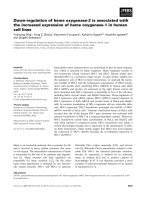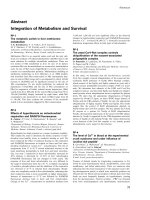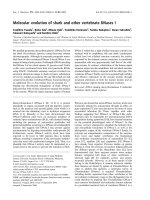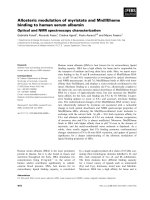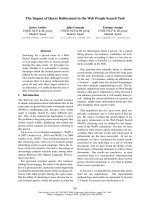Báo cáo khoa học: "Prognostic significance of IDH-1 and MGMT in patients with glioblastoma: One step forward, and one step back" pot
Bạn đang xem bản rút gọn của tài liệu. Xem và tải ngay bản đầy đủ của tài liệu tại đây (350.99 KB, 18 trang )
This Provisional PDF corresponds to the article as it appeared upon acceptance. Fully formatted
PDF and full text (HTML) versions will be made available soon.
Prognostic significance of IDH-1 and MGMT in patients with glioblastoma: One
step forward, and one step back?
Radiation Oncology 2011, 6:115 doi:10.1186/1748-717X-6-115
Stephanie E Combs ()
Stefan Rieken ()
Wolfgang Wick ()
Amir Abdollahi ()
Andreas von Deimling ()
Jurgen Debus ()
Christian Hartmann ()
ISSN 1748-717X
Article type Short report
Submission date 2 April 2011
Acceptance date 13 September 2011
Publication date 13 September 2011
Article URL />This peer-reviewed article was published immediately upon acceptance. It can be downloaded,
printed and distributed freely for any purposes (see copyright notice below).
Articles in Radiation Oncology are listed in PubMed and archived at PubMed Central.
For information about publishing your research in Radiation Oncology or any BioMed Central journal,
go to
/>For information about other BioMed Central publications go to
/>Radiation Oncology
© 2011 Combs et al. ; licensee BioMed Central Ltd.
This is an open access article distributed under the terms of the Creative Commons Attribution License ( />which permits unrestricted use, distribution, and reproduction in any medium, provided the original work is properly cited.
Prognostic significance of IDH-1 and MGMT in
patients with glioblastoma:
One step forward, and one step back?
Stephanie E. Combs
1
, Stefan Rieken
1
, Wolfgang Wick
2
, Amir Abdollahi
1
, Andreas von
Deimling
3,4
, Jürgen Debus
1
and Christian Hartmann
3,4
1
Department of Radiation Oncology, University Hospital of Heidelberg, Heidelberg, Germany
2
Department of Neurooncology, University Hospital of Heidelberg, Heidelberg, Germany
3
Clinical Cooperation Unit Neuropathology, German Cancer Research Center, Heidelberg
Germany
4
Department of Neuropathology, University Hospital of Heidelberg, Heidelberg, Germany
*Corresponding Author:
Priv Doz. Dr. Stephanie E. Combs
Head of the Neuro-Radiation Oncology Research Group
Department of Radiation Oncology
University Hospital of Heidelberg
Im Neuenheimer Feld 400
69120 Heidelberg
Germany
Phon: +49-6221-56-8202
Fax: +49-6221-56-5353
e-mail:
Abstract
A group of 160 patients with primary glioblastoma treated with radiotherapy and
temozolomide was analyzed for the impact of O6-methly-guanly-methyl-transferase (MGMT)-
promoter methylation as well as isocitrate dehydrogenase (IDH)1-mutational status.
Unexpectedly, overall survival or progression-free survival were not longer in the group with
methylated MGMT-promoter as compared to patients without that methylation. IDH-1
mutations were significantly associated with increased overall survival.
Key Words
Glioblastoma, radiation, temozolomide, MGMT, IDH
Introduction
Over recent years, the search for outcome factors in patients with glioblastomas (GBM) has
identified at least two candidates that have shown to be prognostic for progression-free and
overall survival or predictive for response to a particular therapeutic modality, that is
alkylating chemotherapy, in patients with high-grade gliomas. The O6-methylguanine-DNA-
methyltransferase (MGMT) gene encodes MGMT, a protein with DNA repair activity, which
removes alkyl groups from several residues, of which the O6-position of guanine might be
most relevant for the action of an extensively used chemotherapeutic drug, temozolomide, by
an irreversible transfer of the alkyl group to a cystein residue at it’s active side (1;2). The
MGMT expression level and its activity varies widely between different tissues, cell types,
and in particular, between different tumors (3;4). It has been shown that glial brain tumors
are characterized by a low expression of MGMT, however, the activity of MGMT is commonly
increased in relation to surrounding normal tissue (4;5).
MGMT-activity is partly mediated through methylation of the MGMT promoter region; this
epigenetic mechanism contributing to a loss of MGMT-expression has been described by
Esteller et al. (6). The epigenetically mediated silencing of the MGMT gene in GBM has been
shown to correlate with an increased survival: Some studies have shown significant
correlation with MGMT-promoter methylation and outcome to alkylating chemotherapeutic
substances such as temozolomide (TMZ) (7). Moreover, a correlation with outcome
independently of treatment choice, i.e. chemotherapy or radiotherapy, has been postulated
by some authors (7;8).
However, until now, most reports on the prognostic value of MGMT-promoter methylation
have answered this question in a retrospective manner. Additionally, several methods of
MGMT-promoter methylation confirmation have been used within the different studies, and
comparative analyses have shown substantial heterogeneity in results after MGMT-testing.
In the literature, some authors have reported that MGMT promoter methylation might not be
correlated with outcome, either after treatment with radiotherapy, or with alkylating
chemotherapeutic substances (9;10).
Only recently, mutations of the IDH1 gene encoding cytosolic NADP+-dependent isocitrate
dehydrogenase have been show to correlate with outcome in patients with malignant gliomas
(11;12). It has been proposed that IDH1 mutations can be used to distinguish primary from
secondary GBM, since IDH1 mutations are associated with diffuse gliomas WHO Grade II
and III as well as with secondary GBM, whereas primary GBM rarely show IDH1 mutations.
We have treated a large group of patients with primary GBM with radiotherapy and
chemotherapy with temozolomide. To determine the prognostic value of MGMT-promoter
methylation and IDH1 mutational status, we analyzed both markers in a homogenous group
of 160 patients with primary GBM treated with radiation and TMZ and correlated results with
outcome.
Materials and Methods
Patient population
Between 1999 and 2007, 160 consecutive patients with primary, histologically confirmed
GBM were treated with radiation and temozolomide as reported previously (13;14).
After neurosurgical resection, which was complete in 51 patients and subtotal in 66 patients,
patients were treated with 3D-conformal radiation therapy based on CT- and MRI-based
treatment planning. The median age of the patients included was 56 years at primary
diagnosis (range 20-76 months). Patients’ characteristics are shown in table 1.
A median dose of 60 Gy in 2 Gy single fractions was applied. All patients were treated with
concomitant TMZ, and adjuvant TMZ was given in 34 patients. At this time, a phase II trial
evaluation radiation and chemotherapy with TMZ at a dose of 50 mg/m
2
without adjuvant
TMZ was performed in our institution, therefore 124 patients had been treated according to
this regimen, and 36 patients received TMZ according to the Stupp regimen (13;15;16). A
detailed report on patient and treatment characteristics has been published previously (14).
Molecular analyses and immunohistochemistry
Tumor tissue for molecular analysis of MGMT-promoter methylation was available from 127
out of 160 patients (80%). MGMT status was determined using methylation-specific
polymerase chain reaction (6) . Details are described elsewhere (17).
To determine the IDH1-mutational status we used either immunohistochemistry with an
antibody specifically binding the R132H mutational variant of IDH1 (n=125) or direct
sequencing (n=15). To determine the IDH1 status by immunohistochemistry, sections were
cut to 4 µm, dried at 80°C for 15 min and further processed on a Ventana BenchMark XT
immunostainer (Ventana Medical Systems, Tucson, AZ, USA). After 60 min pretreatment
with cell conditioner 2 (pH 6) the slides were incubated with 1:30 diluted H09 antibody
(Dianova, Hamburg, Germany) at 37°C for 32 min. Antibody incubation was followed by
Ventana standard signal amplification, UltraWash, counterstaining with one drop of
hematoxylin for 4 min and one drop of bluing reagent for 4 min. For chromogenic detection
UltraViewTMUniversal DAB Detection Kit (Ventana) was used. Slides were removed from the
immunostainer and mounted. A strong cytoplasmic immunoreaction product was scored
positive. A weak diffuse staining and staining of macrophages were not scored positive. Fig.
1 depicts an example of the immunohistochemistry as well as sequencing results.
Statistical Analysis
All patients were seen for regular follow-up and clinical data was collected in the institutions’s
database. For the present analysis, we correlated status of MGMT-promoter methylation as
well as IDH-1 mutational status with patients’ characteristics and outcome.
Overall survival (OS) was calculated from the date of primary diagnosis until death or last
observation during follow up (censored data). Progression-free survival (PFS) was
determined from the time of the beginning of radiotherapy and chemotherapy until tumor
progression or to last observation or death if none occurred (censored data). OS and PFS
were calculated using the Kaplan-Meier-Method. Survival curves for prognostic factors were
compared using a two-sided log rank test. All statistical analyses were performed using the
Statistica 6.1 software (Statsoft, Tulsa, OK, USA).
Results
Molecular analyses: MGMT Promoter Methylation
Of the 127 patients analyzed, the MGMT-promoter was methylated in 43 patients (34%) and
was unmethylated in 84 patients (66%).
MGMT-promoter methylation did not correlate with overall survival (OS; p=0.18 (Fig. 2 A)).
Additionally progression-free-survival was not influenced by MGMT-promoter methylation
status (p=0.93; Fig. 2 B).
Looking at subgroups, we analyzed the impact of MGMT- promoter methylation on OS and
PFS in patients ≤ 60 yrs. (n=85; 53%) and > 60 yrs. (n=75; 47%). In the younger age group
MGMT-promoter methylation did not influence OS (p=0.93) or PFS (p=0.69). However, in
older patients, MGMT-promoter methylation was associated with a significant increase in OS
(p=0.02), however PFS was comparable (p=0.11).
Molecular analyses and immunohistochemistry: IDH1
Four of the 140 patients (3%) showed an IDH1 mutation; all mutations were of the R132H
variant. The 4 patients with a positive IDH1 mutations status showed significantly longer OS
(p=0.002; Fig. 3A), but unaltered PFS (p=0.25) than patients with wildtype IDH1.
Discussion
In the present analysis we evaluated the impact of MGMT-promother methylation as well as
IDH1-mutational status on outcome in 160 patients with GBM treated with radiation and
temozolomide. IDH1 mutations occur in approximately 60 – 80 % of diffusely infiltrating
gliomas of the WHO grades II and III and in secondary GBM but only in around 5 % of
primary GBM (11;18-22). In our series we identified in 4 of 140 patients (3 %) IDH-1
mutations. Currently, it remains unclear if at least some of the patients with clinically defined
primary GBM and IDH1 mutations may actually have suffered from secondary GBM that
rapidly progressed from less malignant precursor lesions that escaped diagnosis (23). In
summary, IDH1 is a sufficient marker that allows a better separation of primary GBM from
other malignant astrocytomas than any other marker and will help to define more accurately
this tumor entity in upcoming studies. The low number of primary GBM exhibiting IDH1
mutations in our series indicates that our sample set consists indeed predominately of these
tumors. IDH1mutations in GBM were found in general in younger patients and were
associated with a better prognosis (22-24). This has been confirmed in the present study,
showing that IDH1 mutational status, although only positive in few patients, is associated
with younger age and lower survival times than in the group of patients with wildtype IDH1.
Therefore, the pattern of IDH1 mutations confirm that the present group of 160 patients with
GBM is a very homogeneous group with respect to histological clasification.
In contrast to most studies, MGMT-promoter methylation was not associated with an
increase in OS or PFS; both endpoints were comparable in patients with active MGMT or
with MGMT silencing. The only subgroup of patients showing a significant impact of MGMT-
promoter methylation on survival were patients older than 60 years, where MGMT-promoter
methylation was associated with an increase in OS. This is in contrary to the results
published by Stupp and colleagues (7;15). Therefore, the strong impact on MGMT-promoter
methylation might not hold true for all age groups of patients with GBM. The EORTC
26981/22981/NCIC CE.3 study by Stupp et al. determining the role for chemoradiation with
temozolomide has shown MGMT-promoter methylation to be strongly associated with an
improved outcome (7;15). In contrast, other studies in anaplastic gliomas have shown that
MGMT-methylation status dose not only influence outcome after alkylkating chemotherapies
but also radiotherapy and may therefore be prognostic rather than predictive. This is reported
by numerous other studies (8). However, controversial results have also been published in
groups of GBM patients, in which MGMT-status is not associated with differences in
outcome: Costa et al. reports on 90 GBM-patients treated with temozolomide-based
chemoradiation where MGMT promoter methylation was not associated with increased
outcome (10). Park et al. published 48 patients treated with alkylating chemotherapy and
could not confirm a significant impact of methylation status of MGMT gene promoter (9).
Many arguments may be brought forward to explain these differing clinical data, including the
various methods of measurement of MGMT-activity sometimes showing discrepant results,
differences between frozen or paraffin embedded tissues. Additionally, when analyzing
different chemotherapeutic combinations, substances such as cisplatinum might inactivate or
attenuate MGMT-status thus influencing the clinical outcome when combined with alkylating
chemotherapies. An important differential explanation is the variation of the treatment in our
cohort as compared to the published data (7;16;17;25;26) with a lower exposure of our
patients to alkylating chemotherapy both in the concomitant phase (50 mg in 78% and 75 mg
in only 22%) as well as in the maintenance phase (no adjuvant treatment in 79 % and a
mean of 6 cycles in 21% of patients). However, inspite of this difference, outcome between
the two dosing groups of temozolomide was identical, therefore counteracting this argument.
In conclusion, controversial results exist on the impact of MGMT-promoter methylation status
in patients with GBM, and further studies will hopefully further clarify these differences. At
this time, in spite of the strong evidence for a high impact of MGMT-promoter methylation,
differentiating treatment strategies based on MGMT-promoter methylation status should
therefore be applied within the framework of clinical studies only.
Conflict of interest
The authors declare that they have no conflict of interest.
Authors’ contributions
SC, SR, WW and JD treated the patients and collected the cllinical data. SC and JD
performed the clinical analysis of the dataset. CH and AvD performed the histopathological
and molecular analysis. SC, JD, CH and AA analyszed the prognostic relevance of the
molecular data. SC and CH wrote the mansucript. JD, AvD, WW, SR and AA helped with
manuscript finalization and discussion.
Reference List
1. Pegg AE. Repair of O(6)-alkylguanine by alkyltransferases. Mutat.Res. 2000;462:83-100.
2. Ludlum DB. DNA alkylation by the haloethylnitrosoureas: nature of modifications produced
and their enzymatic repair or removal. Mutat.Res. 1990;233:117-26.
3. Margison GP, Povey AC, Kaina B, Santibanez Koref MF. Variability and regulation of O6-
alkylguanine-DNA alkyltransferase. Carcinogenesis 2003;24:625-35.
4. Citron M, Decker R, Chen S, Schneider S, Graver M, Kleynerman L et al. O6-methylguanine-
DNA methyltransferase in human normal and tumor tissue from brain, lung, and ovary. Cancer
Res. 1991;51:4131-4.
5. Silber JR, Mueller BA, Ewers TG, Berger MS. Comparison of O6-methylguanine-DNA
methyltransferase activity in brain tumors and adjacent normal brain. Cancer Res.
1993;53:3416-20.
6. Esteller M, Hamilton SR, Burger PC, Baylin SB, Herman JG. Inactivation of the DNA repair
gene O6-methylguanine-DNA methyltransferase by promoter hypermethylation is a common
event in primary human neoplasia. Cancer Res. 1999;59:793-7.
7. Hegi ME, Diserens AC, Gorlia T, Hamou MF, de Tribolet N, Weller M et al. MGMT gene
silencing and benefit from temozolomide in glioblastoma. N.Engl.J Med. 2005;352:997-1003.
8. Wick W, Hartmann C, Engel C, Stoffels M, Felsberg J, Stockhammer F et al. NOA-04
randomized phase III trial of sequential radiochemotherapy of anaplastic glioma with
procarbazine, lomustine, and vincristine or temozolomide. J Clin Oncol 2009;27:5874-80.
9. Park CK, Park SH, Lee SH, Kim CY, Kim DW, Paek SH et al. Methylation status of the MGMT
gene promoter fails to predict the clinical outcome of glioblastoma patients treated with ACNU
plus cisplatin. Neuropathology. 2009;29:443-9.
10. Costa BM, Caeiro C, Guimaraes I, Martinho O, Jaraquemada T, Augusto I et al. Prognostic
value of MGMT promoter methylation in glioblastoma patients treated with temozolomide-
based chemoradiation: a Portuguese multicentre study. Oncol Rep. 2010;23:1655-62.
11. Hartmann C, Meyer J, Balss J, Capper D, Mueller W, Christians A et al. Type and frequency
of IDH1 and IDH2 mutations are related to astrocytic and oligodendroglial differentiation and
age: a study of 1,010 diffuse gliomas. Acta Neuropathol. 2009;118:469-74.
12. Capper D, Weissert S, Balss J, Habel A, Meyer J, Jager D et al. Characterization of R132H
mutation-specific IDH1 antibody binding in brain tumors. Brain Pathol. 2010;20:245-54.
13. Combs SE, Gutwein S, Schulz-Ertner D, van Kampen M, Thilmann C, Edler L et al.
Temozolomide combined with irradiation as postoperative treatment of primary glioblastoma
multiforme. Phase I/II study. Strahlenther.Onkol. 2005;181:372-7.
14. Combs SE, Wagner J, Bischof M, Welzel T, Edler L, Rausch R et al. Radiochemotherapy in
patients with primary glioblastoma comparing two temozolomide dose regimens. Int J
Radiat.Oncol Biol Phys 2008;71:999-1005.
15. Stupp R, Mason WP, van den Bent MJ, Weller M, Fisher B, Taphoorn MJ et al. Radiotherapy
plus concomitant and adjuvant temozolomide for glioblastoma. N.Engl.J Med. 2005;352:987-
96.
16. Stupp R, Hegi ME, Mason WP, van den Bent MJ, Taphoorn MJ, Janzer RC et al. Effects of
radiotherapy with concomitant and adjuvant temozolomide versus radiotherapy alone on
survival in glioblastoma in a randomised phase III study: 5-year analysis of the EORTC-NCIC
trial. Lancet Oncol 2009;10:459-66.
17. Weiler M, Hartmann C, Wiewrodt D, Herrlinger U, Gorlia T, Bahr O et al. Chemoradiotherapy
of newly diagnosed glioblastoma with intensified temozolomide. Int J Radiat.Oncol Biol Phys
2010;77:670-6.
18. Balss J, Meyer J, Mueller W, Korshunov A, Hartmann C, von Deimling A. Analysis of the IDH1
codon 132 mutation in brain tumors. Acta Neuropathol. 2008;116:597-602.
19. Ichimura K, Pearson DM, Kocialkowski S, Backlund LM, Chan R, Jones DT et al. IDH1
mutations are present in the majority of common adult gliomas but rare in primary
glioblastomas. Neuro Oncol 2009;11:341-7.
20. Parsons DW, Jones S, Zhang X, Lin JC, Leary RJ, Angenendt P et al. An integrated genomic
analysis of human glioblastoma multiforme. Science 2008;321:1807-12.
21. Watanabe T, Nobusawa S, Kleihues P, Ohgaki H. IDH1 mutations are early events in the
development of astrocytomas and oligodendrogliomas. Am J Pathol. 2009;174:1149-53.
22. Yan H, Parsons DW, Jin G, McLendon R, Rasheed BA, Yuan W et al. IDH1 and IDH2
mutations in gliomas. N.Engl.J Med. 2009;360:765-73.
23. Nobusawa S, Watanabe T, Kleihues P, Ohgaki H. IDH1 mutations as molecular signature and
predictive factor of secondary glioblastomas. Clin Cancer Res. 2009;15:6002-7.
24. Sanson M, Marie Y, Paris S, Idbaih A, Laffaire J, Ducray F et al. Isocitrate dehydrogenase 1
codon 132 mutation is an important prognostic biomarker in gliomas. J Clin Oncol
2009;27:4150-4.
25. Glas M, Happold C, Rieger J, Wiewrodt D, Bahr O, Steinbach JP et al. Long-term survival of
patients with glioblastoma treated with radiotherapy and lomustine plus temozolomide. J Clin
Oncol 2009;27:1257-61.
26. Herrlinger U, Rieger J, Koch D, Loeser S, Blaschke B, Kortmann RD et al. Phase II trial of
lomustine plus temozolomide chemotherapy in addition to radiotherapy in newly diagnosed
glioblastoma: UKT-03. J Clin Oncol 2006;24:4412-7.
Figures:
Figure 1
GBM sample with an IDH1 R132H mutation demonstrated by IHC and sequencing.
Figure 2
Correlation of overall survival (A) and progression-free survival (B) with MGMT-promotor
methylation. For both endpoints, MGMT-activity did not significantly influence outcome.
Figure 3
IDH-1 mutational status did influcence overall survival in 160 patients treated with radiation
and temozolomide (p=0.002).
Table 1 - Patients’ characteristics of 160 patients treated with radiation and temozolomide for
primary glioblastoma.
Characteristic N (%)
Age - years
median
56
range
20-76
Age – no. (%)
< 50
38 (24)
≥ 50
122 (76)
Sex – number (%)
female
66 (41)
male
94 (59)
Karnofsky Performance Score
≥ 70
115 (72)
< 70
45 (28)
Extent of surgery – no. (%)
biopsy
43 (27)
complete resection
51 (32)
partial resection
66 (41)
RPA/EORTC-Classification
III
33 (21)
IV
90 (56)
V
37 (23)
Time from diagnosis to RT - days
median
24
range
7-98
Corticosteroid therapy – no. (%)
yes
113 (71)
no
47 (29)
Anti-seizure medication – no. (%)
yes
75 (47)
no
85 (53)
Figure 1
Figure 2
Figure 3




